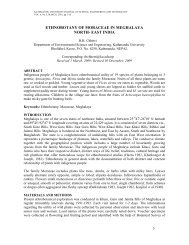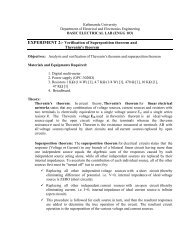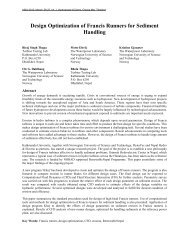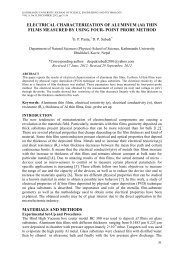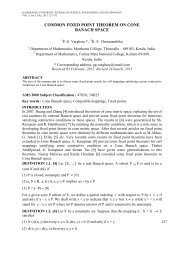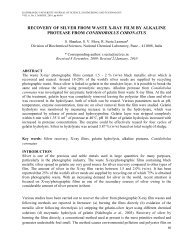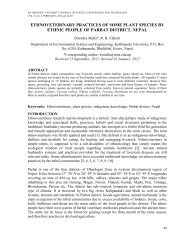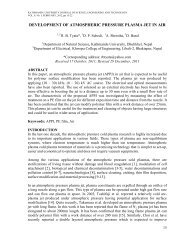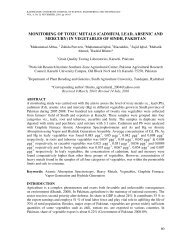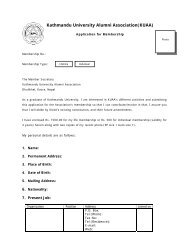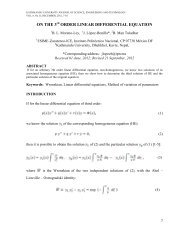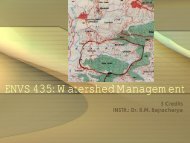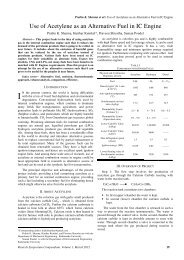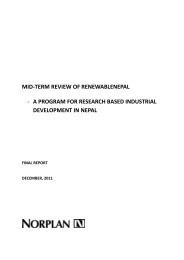Production of biogas from kitchen waste, Laxman Lama, Sunil ...
Production of biogas from kitchen waste, Laxman Lama, Sunil ...
Production of biogas from kitchen waste, Laxman Lama, Sunil ...
- No tags were found...
Create successful ePaper yourself
Turn your PDF publications into a flip-book with our unique Google optimized e-Paper software.
L. <strong>Lama</strong>, SP Lohani, R <strong>Lama</strong>, and JR Adhikari: <strong>Production</strong> <strong>of</strong> <strong>biogas</strong> <strong>from</strong> <strong>kitchen</strong> <strong>waste</strong>Initially 200-300 kg <strong>of</strong> cow dung were gradually mixedwith water and made slurry <strong>of</strong> about 500-600 L withremoval <strong>of</strong> straw material (Figure 5) [3]. The homogenousmass was then poured into the digester. Following theinstallation and inoculation, the digester was left withoutfeeding for 30 days to develop the culture inside thedigester. After that started to put the <strong>kitchen</strong> <strong>waste</strong> into thedigester.Fig. 5: Preparation <strong>of</strong> cow dung and putting it into the digester tostart- up the processPre-Treatment and Dilution <strong>of</strong> Feedstock:The objective <strong>of</strong> pre-treatment is to reduce the size <strong>of</strong>substrate particles in order to meet the basic requirement <strong>of</strong>fitting into the 4”- inlet-pipe. In addition, increasing thesurface <strong>of</strong> the feedstock allows better digestion for thebacteria responsible for the hydrolysis. The pieces <strong>of</strong> bothsubstrates were treated previous to the feeding to attain aparticle size <strong>of</strong> less than 1cm. In our study, the pre-treatment<strong>of</strong> food <strong>waste</strong> was only needed for the meat, fish and fruitpieces. They were cut up with a <strong>kitchen</strong> knife. Then putthem into the chopper to make smaller size.Preparation <strong>of</strong> Feedstock and Feeding Procedure:Organic household <strong>waste</strong> primarily consists <strong>of</strong> <strong>kitchen</strong><strong>waste</strong>, which can be divided into food leftovers and peelingsor pieces <strong>of</strong> vegetables and fruits. The food leftoversconsisted <strong>of</strong> rice, lentil, curry, vegetable (beans), potatochips, and pieces <strong>of</strong> meat with sauce and fish residue.Orange and banana peelings were also merged into the foodremains. Tooth picks and meat bones were frequently amongthe food <strong>waste</strong> and had to be removed. Fruit and vegetable<strong>waste</strong> was also obtained during the <strong>waste</strong> collection period.Its composition was spoiled fruits (papaya, orange, banana,and pineapple), spoiled vegetables (tomato, eggplant, carrot,potato, cucumber, onion, and broccoli) and vegetablepeelings (cabbage, bean). All <strong>waste</strong>s were stored in closedbuckets and used within a maximum <strong>of</strong> 4 days. Daily inaverage 5Kg <strong>of</strong> dry <strong>waste</strong> was collected and directly pouredinto the chopper and around 50% <strong>of</strong> water is also added tomake slurry. Then chop all the <strong>kitchen</strong> <strong>waste</strong> by the use <strong>of</strong>chopper to make sure that all size <strong>of</strong> <strong>waste</strong> are less than1cm.The liquid slurry <strong>from</strong> the chopper is also directly input tothe digester.Gas Measurements:The daily produced volume <strong>of</strong> gas was measured by twomethods.1. Height difference method2. Burn methodHeight difference method: This method includes themarking <strong>of</strong> the minimum and maximum point on thegasholder and then measuring tape was used to measure theexact height <strong>of</strong> produced gas in the digester. The gear valvewas open to release the gas and then closed to mark theminimum (initial) height. The gas holder rises up to thecertain limit because <strong>of</strong> daily slurry input and that height isrecorded as final height <strong>of</strong> the produced gas. The differencebetween the final and initial height gives the exact heightdifference <strong>of</strong> the produce gas. [4]Burn method: In this method, the gas stove was used toburn the produce gas and daily burning time after theaddition <strong>of</strong> <strong>kitchen</strong> <strong>waste</strong> was also recorded to know the rate<strong>of</strong> produce gas. [4]Gas Composition:The Dräger X-am 7000 (Gas Analyzer) was used tomeasure the volume percentage <strong>of</strong> methane (CH 4 ) andcarbon dioxide (CO 2 ) in the <strong>biogas</strong>. The gas compositionwas measured on a daily basis in the afternoon (beforefeeding) while releasing the gas.Gas (L)250200150100500IV. RESULTS AND DISCUSSIONS1 5 9 13 17 21 25 29 33 37 41 45 49 53 57 61DaysFig. 6: Gas production versus daysThe line graph shows how the production <strong>of</strong> gas changedday by day on daily feeding <strong>of</strong> average 5 kg <strong>of</strong> dry <strong>kitchen</strong><strong>waste</strong>, obtained after the 10 days to 16 days <strong>from</strong> thefeeding <strong>of</strong> <strong>kitchen</strong> <strong>waste</strong>, measured by height differencemethods. The first day <strong>of</strong> the feeding <strong>of</strong> <strong>kitchen</strong> <strong>waste</strong>represents 31 days in the above graph.Rentech Symposium Compendium, Volume 2, December 2012 16



